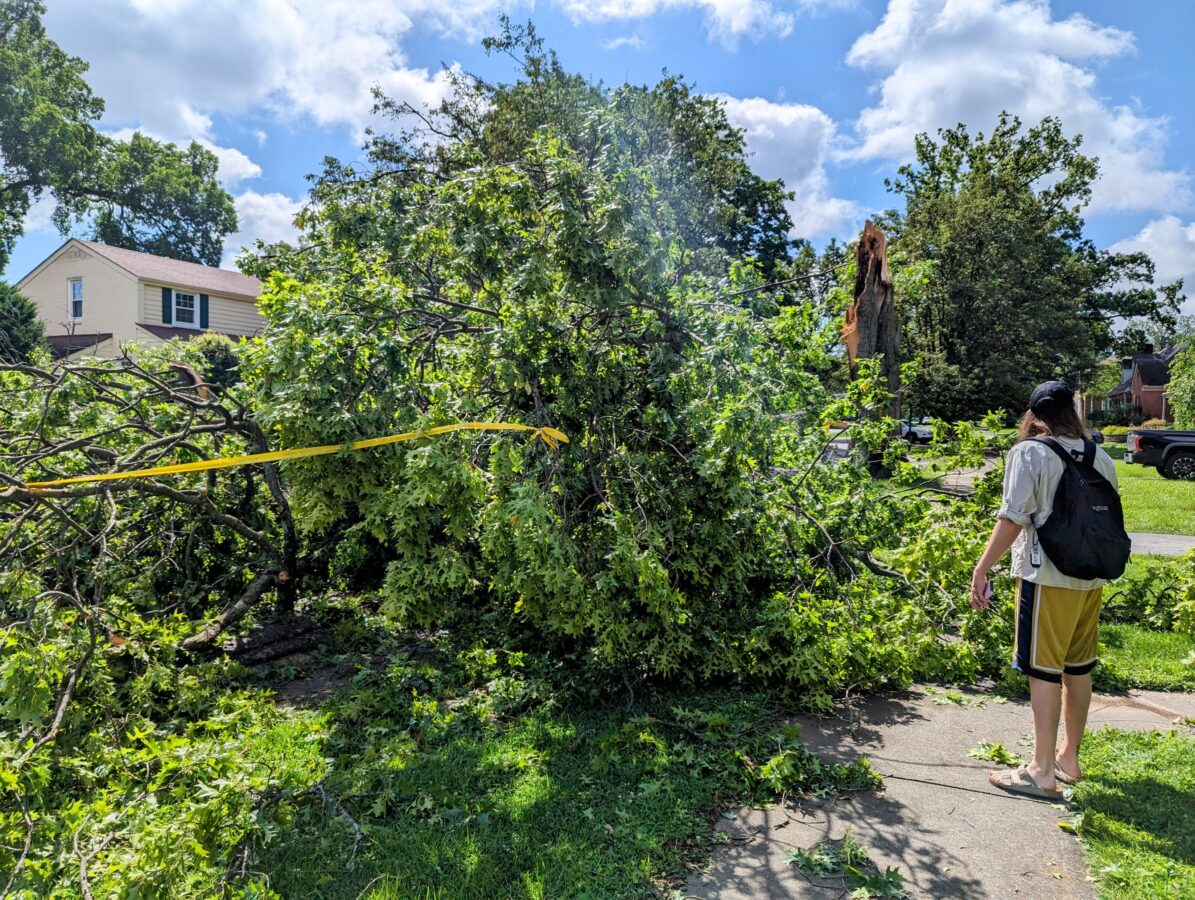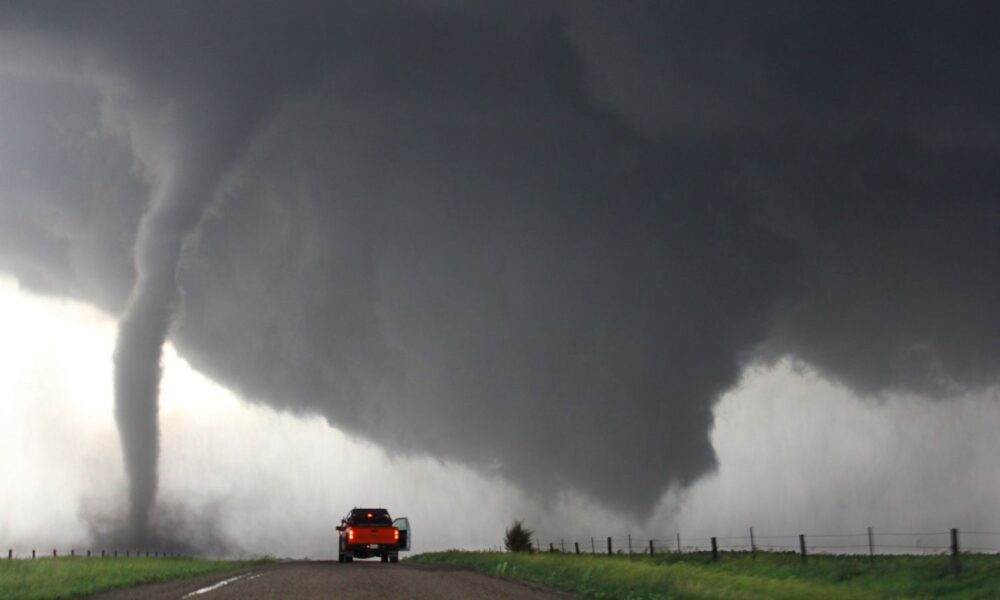I was a young’n when I first saw Twister in the 90s. Even though we rarely had tornadoes in my hometown in Kentucky back then, it left an impression. The opening scene shows a young girl losing her dad to a tornado as he gets her to safety, and it absolutely terrified me. Every time we had a severe storm or tornado warning, I would grab my flashlight and beg my dad to get us all into the basement so we could be safe. Nearly thirty years later, I’m still afraid of tornadoes, there’s a new Twisters movie out in theaters, AND Tornado Alley has shifted to where I live.
I saw Twisters on opening weekend, and here’s what I took away (minor spoilers ahead):
1. Hillbillies, data geeks, and city folk—oh my!
When I saw the movie trailer, I knew there was going to be a line about hillbillies, and sure enough, there was. The scene isn’t that hard to imagine: a group of folks show up in a big ole truck, blasting country music, saying yee-haw, and wearing cowboy hats. Who are they? “Hillbillies with a YouTube channel,” says one of the clean-cut data guys.
First, being from Kentucky, I gotta speak out about terms like “hillbillies” and “rednecks.” Often people use these terms as insults (and I’ve been on the receiving end of them myself). Doing so ignores the systems of oppression and disenfranchisement that have affected, and continue to affect people living in the south and Appalachia.
Though let me be clear: there are some folks who use these terms to excuse their racism and bigotry, and that is never okay.
I love to see people who are proud of their hillbilly roots and are shifting the narrative, like a mutual aid group in Eastern Kentucky who calls themselves “Hillbillies Helping Hillbillies.” They’re the ones making sure their neighbors have food, water, and shelter, especially after disaster—be it floods or a tornado—strikes. You see this in the film: once the storm clears, neighbors come together to help each other pick up the pieces.
From this early scene it seems like the film is going to be a classic, stereotypical “scientists” (data geeks) versus “non-scientists” (hillbillies) story. Luckily, that’s not the case!
2. Science is for everyone. What matters is what you do with it
Everyone in the film is an expert or a scientist, really. The Storm Par team mostly went to Ivy League schools; Tyler, the tornado wrangler and cowboy scientist, trained as a meteorologist; Dexter is a scientist; Lilly brings her technical expertise as the drone operator; and Kate has some educational training, but also relies on what she learned growing up in Oklahoma. There are many types of knowledge, and you don’t have to have a formal academic education to be an expert. Lived experience is expertise. In the film, it’s that lived expertise that makes Kate a better storm chaser.
This is vital to understand in the real world, because Traditional Ecological Knowledge and the lived experiences of community members in environmental justice and frontline communities, for example, are valid and deserve to be considered in decision-making spaces.
The tornadoes are not the “bad guy”—they’re a mighty force of nature. The true villain in the movie is a predatory developer who wants to use Storm Par’s data so he can swoop in and buy land from folks affected by tornadoes, offering “all cash offers” to people who are “underinsured.” Disasters make people more vulnerable to displacement, and the process of rebuilding after a disaster can take a long time—and shouldn’t be subverted by profit-hungry corporations looking to make a buck.
This conflict is driven home when an exploding oil refinery creates a fire tornado and Javi, storm chaser and founder of Storm Par, must decide between saving his company’s data or rushing ahead to warn people in the path of the storm. This is his defining moment: Will he choose good, or greed?
3. Investments are needed to keep people safe
Twisters is filmed in Oklahoma, which has been the epicenter of Tornado Alley. In recent years, tornado activity may be shifting eastward—making tornadoes in places like Kentucky, Indiana, and Illinois, where people are less prepared, more likely. The film shows that even people who live in places where tornadoes are common often don’t have access to safe shelter during severe storms, which can come on quickly with little to no warning.
We know that investing in resilience is smart: every dollar invested in disaster mitigation saves $6. As my colleague Brenda Ekwurzel wrote after the historic tornado outbreak that ripped across the Midwest and into central Kentucky in December 2021:
“It is more than worth it to invest in ways to improve weather forecasts and communication of the risks with such powerful extreme events. Just as important is investing in improving the factors on the ground that reduce exposure and vulnerability, especially for communities that may be exposed to greater risks as tornado activity increases for different areas.”
Scientists at the National Oceanic and Atmospheric Administration (NOAA) are responsible for weather forecasts and severe storm warnings, information we likely take for granted. I think it’s really cool that NOAA scientists were consulted on Twisters to make sure the film was accurate and realistic because, “Just like the characters in the movie, real NOAA scientists are focused on saving lives in the face of these potentially lethal storms.” I hope movie viewers will be encouraged to learn more about the important work NOAA scientists do to keep us all safe, and to push back against efforts from those (including the folks behind the anti-science, anti-democratic Project 2025) who seek to dismantle NOAA and privatize weather data.
After the movie ends: the real-life work of disaster recovery
There are lots of efforts for disaster recovery and relief that take place after a storm. Twisters only briefly gives us a look into this work. Here in Kentucky, Governor Andy Beshear established the Team Western Kentucky Relief Fund, which raised over $52 million to provide survivors of the December 2021 tornadoes with housing, rent, and funeral expenses. The Kentucky Housing Coalition has also provided ongoing resources to Kentuckians in need. Sadly, in May of this year, another tornado ripped through western KY and destroyed homes that had only recently been rebuilt. While it’s great to see folks come together, we must do more to prepare before storms hit to reduce the loss of life and damage.

Tornadoes and severe storms are hitting closer to home for me, literally. I want everyone to feel and be safe when threatened by severe storms. There is a real need and opportunity to invest in people, and communities—and scientists, government agencies, community leaders, mutual aid groups, and more folks must work together on solutions. Local government leaders, for example, can take advantage of federal programs like the Federal Emergency Management Agency (FEMA) Building Resilient Infrastructure and Communities program to invest in disaster preparedness and risk reduction.
Something we can all do is talk about these issues with our friends and families! Climate scientist Katharine Hayhoe asserts that talking about climate change is the most important thing we can do. After seeing the film, ask your friends: “Is Twisters a climate change movie?”
So, grab your cowboy hat, get to your local movie theater to see Twisters, and enjoy the ride. And then, let’s continue the work to keep people safe.

